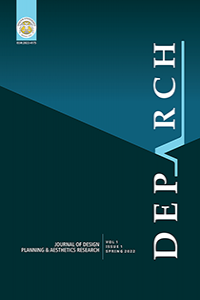Abstract
References
- Adorno, T. W. (2005). [1965] Functionalism today. In N. Leach(Ed.). Rethinking architecture, a reader in cultural theory (pp. 5-18). Routledge.
- Ashton, A. (2003). Harmonography. A visual guide to the mathematics of music. Walker and Company.
- Bök, C. (1997). Pataphysics. The poetics of an imaginary science (Unpublished Doctoral dissertation). York University.
- Gillespie, S. & Hardy, P. (Eds.) (2010). The Cambridge companion to Lucretius. Cambridge University Press.
- Joachim, H. H. (1958). Spinoza’s tractatus de intellectus emendatione, A Commentary. Oxford.
- Loos, A. (2014). Süsleme ve suç. In A. Looos (Ed.). Adolf Loos: Mimarlık üzerine (pp. 161-172). (A. Tümertekin, N. Ülner, Trans.). Janus Yayıncılık. (Original work published 1929).
- Loos, A. (2014). Süsleme ve eğitim. In A. Looos (Ed.). Adolf Loos: Mimarlık Üzerine (pp. 153-160). (A. Tümertekin, N. Ülner, Trans.). Janus Yayıncılık. (Original work published 1929).
- Lucretius Carus, T. (2000). Evrenin yapısı. (T. Uyar, T. Uyar, Trans.). İyi Şeyler. (Original work published 1708).
- Lucretius Carus, T. (2001). On the nature of things. (M. F. Smith, Trans.). Hackett Publishing.(Original work published 1708).
- Nietzsche, F. (2017). Putların alacakaranlığı ya da çekiçle felsefe nasıl yapılır?. (M. Tüzel, Trans.) İş Bankası. (Original work published 1896).
- Nietzsche, F. (1980). Twilight of the idols or how to philosophize with a hammer. (D. Large, Trans.) Penguin. (Original work published 1889).
- Wigley, M. (2001). White walls designer dresses. The Fashioning of modern architecture. MIT Press.
- URL 1- https://www.academia.edu/28249504/mimarlıkta_su_sün_ve_suc_un_yu_z_yıllık_anlamları_pdf (14 02 2022)
- URL 2- https://evrimagaci.org (14 02 2022)
- URL 3: https://www.youtube.com/channel/UCatnasFAiXUvWwH8NlSdd3A (14 02 2022)
- URL 4- https://www.academia.edu/45113821/Harmonografiden_Sınır_Sonrasında_Diyagram_Betonart_59_2018_ (14 02 2022)
- URL 5- https://www.youtube.com/watch?v=asV8GebOA80 (Ahmet İnam, Nietzsche / Readings on Twilight of the Idols, 2/10, 27 05 2019, Ankara.)
- URL 6- Ulus Baker, February – May 1998, Seminars on Art and Desire. (26 12 2020) https://www.youtube.com/watch?v=3LX4SSX9L1w&list=PLuzUG_OWgVKdvkEZ8fhzc6SrDRlCSVDfp
- URL 7- Corry Shores, 2008. Genetic Definition in Spinoza’s Improvement of the Understanding §§91-97, with Deleuze’s Commentary. Spinoza, On the Improvement of the Understanding (Treatise on the Emendation of the Intellect) (14 02 2022) http://piratesandrevolutionaries.blogspot.com/2008/12/genetic-definition-in-spinozas.html
Abstract
In this article, I will stop by an ancient source, De Rerum Natura, Lucretius’ unaccomplished two-thousand-year-old masterpiece, and try to delve into the centuries-old roots of ornamentation much older than from Gottfried Semper’s Bekleidung (dressing) principle of the nineteenth century. Lucretius’s approach, grounded on Epicurus’ atomism, discloses how nature embellishes and creates existences with this queer principle, starting from atoms, with deviation from end to end. (In the twentieth century, though, we are now aware of the divisibility of atoms and the existence of subatomic particles.) After including these passages, I will try to take a closer look at Adorno’s text, in which he sarcastically states that, the effort to purify has turned into a style itself. After a micro-investigation on the representation of nature, I will conclude my article with a discussion in which I expressed my concerns that the anti-ornamentalism sometimes haunts academic writing under the guise of being scientific.
References
- Adorno, T. W. (2005). [1965] Functionalism today. In N. Leach(Ed.). Rethinking architecture, a reader in cultural theory (pp. 5-18). Routledge.
- Ashton, A. (2003). Harmonography. A visual guide to the mathematics of music. Walker and Company.
- Bök, C. (1997). Pataphysics. The poetics of an imaginary science (Unpublished Doctoral dissertation). York University.
- Gillespie, S. & Hardy, P. (Eds.) (2010). The Cambridge companion to Lucretius. Cambridge University Press.
- Joachim, H. H. (1958). Spinoza’s tractatus de intellectus emendatione, A Commentary. Oxford.
- Loos, A. (2014). Süsleme ve suç. In A. Looos (Ed.). Adolf Loos: Mimarlık üzerine (pp. 161-172). (A. Tümertekin, N. Ülner, Trans.). Janus Yayıncılık. (Original work published 1929).
- Loos, A. (2014). Süsleme ve eğitim. In A. Looos (Ed.). Adolf Loos: Mimarlık Üzerine (pp. 153-160). (A. Tümertekin, N. Ülner, Trans.). Janus Yayıncılık. (Original work published 1929).
- Lucretius Carus, T. (2000). Evrenin yapısı. (T. Uyar, T. Uyar, Trans.). İyi Şeyler. (Original work published 1708).
- Lucretius Carus, T. (2001). On the nature of things. (M. F. Smith, Trans.). Hackett Publishing.(Original work published 1708).
- Nietzsche, F. (2017). Putların alacakaranlığı ya da çekiçle felsefe nasıl yapılır?. (M. Tüzel, Trans.) İş Bankası. (Original work published 1896).
- Nietzsche, F. (1980). Twilight of the idols or how to philosophize with a hammer. (D. Large, Trans.) Penguin. (Original work published 1889).
- Wigley, M. (2001). White walls designer dresses. The Fashioning of modern architecture. MIT Press.
- URL 1- https://www.academia.edu/28249504/mimarlıkta_su_sün_ve_suc_un_yu_z_yıllık_anlamları_pdf (14 02 2022)
- URL 2- https://evrimagaci.org (14 02 2022)
- URL 3: https://www.youtube.com/channel/UCatnasFAiXUvWwH8NlSdd3A (14 02 2022)
- URL 4- https://www.academia.edu/45113821/Harmonografiden_Sınır_Sonrasında_Diyagram_Betonart_59_2018_ (14 02 2022)
- URL 5- https://www.youtube.com/watch?v=asV8GebOA80 (Ahmet İnam, Nietzsche / Readings on Twilight of the Idols, 2/10, 27 05 2019, Ankara.)
- URL 6- Ulus Baker, February – May 1998, Seminars on Art and Desire. (26 12 2020) https://www.youtube.com/watch?v=3LX4SSX9L1w&list=PLuzUG_OWgVKdvkEZ8fhzc6SrDRlCSVDfp
- URL 7- Corry Shores, 2008. Genetic Definition in Spinoza’s Improvement of the Understanding §§91-97, with Deleuze’s Commentary. Spinoza, On the Improvement of the Understanding (Treatise on the Emendation of the Intellect) (14 02 2022) http://piratesandrevolutionaries.blogspot.com/2008/12/genetic-definition-in-spinozas.html
Details
| Primary Language | English |
|---|---|
| Subjects | Architecture |
| Journal Section | Research Articles |
| Authors | |
| Publication Date | May 6, 2022 |
| Submission Date | February 15, 2022 |
| Published in Issue | Year 2022 Volume: 1 Issue: 1 |
CREATIVE COMMONS
Open access articles in DEPARCH are licensed under a Creative Commons Attribution-NonCommercial 4.0 International License.


